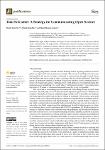Browsing by Author Ho, Manh Tung
Showing results [3 - 6] / 6
Biometric technologies are becoming more pervasive in the workplace, augmenting managerial processes such as hiring, monitoring and terminating employees. Until recently, these devices consisted mainly of GPS tools that track location, software that scrutinizes browser activity and keyboard strokes, and heat/motion sensors that monitor workstation presence. Today, however, a new generation of biometric devices has emerged that can sense, read, monitor and evaluate the affective state of a worker. |
In this book, Andrew McStay introduces the state-of-the-art emotional artificial intelligence (AI) which involves new media technologies that have acquired greater ability to read, sense, track, and classify human emotions, thanks to the rise of big data and computational power. |
In this book, Andrew McStay introduces the state-of-the-art emotional artificial intelligence (AI) which involves new media technologies that have acquired greater ability to read, sense, track, and classify human emotions, thanks to the rise of big data and computational power. |
This paper seeks to introduce a strategy of science communication: Total SciComm or all-out science communication. We proposed that to maximize the outreach and impact, scientists should use different media to communicate different aspects of science, from core ideas to methods. The paper uses an example of a debate surrounding a now-retracted article in the Nature journal, in which open data, preprints, social media, and blogs are being used for a meaningful scientific conversation. The case embodied the central idea of Total SciComm: the scientific community employs every medium to communicate scientific ideas and engages all scientists in the process. |




